Award-winning author Maria Gill interviews Olympian Lisa Carrington and illustrator Scott Pearson about their new books Lisa Carrington Chases a Champion and Ko Lisa Carrington me te Toa Whakaihuwaka.
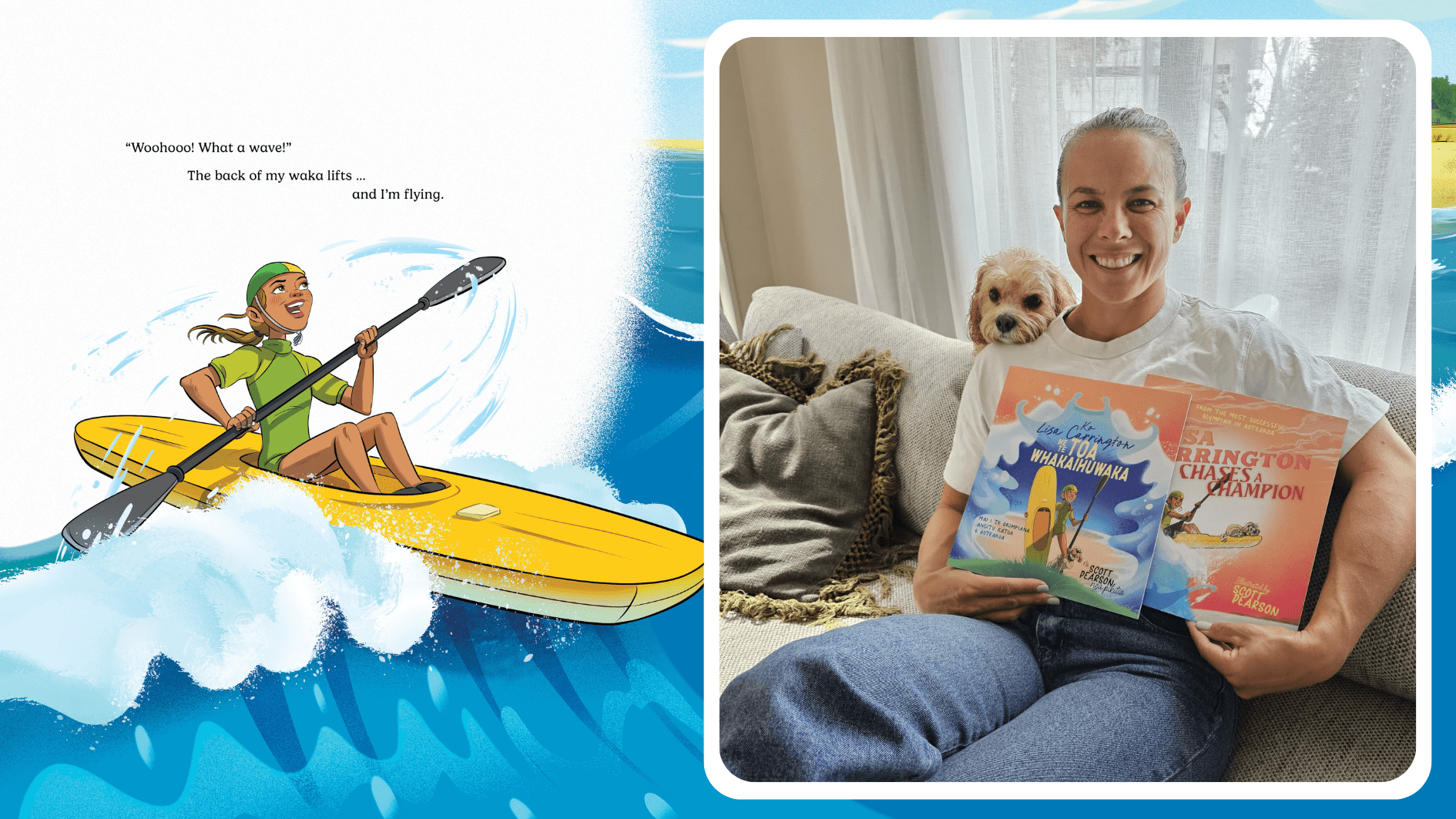
I last interviewed Lisa Carrington for a children’s nonfiction book called New Zealand Sports Hall of Fame in 2013. She had just won a gold medal for kayaking at the 2012 Olympics and already had a gold medal from the women’s world championship. Lisa was the first New Zealand woman to win a canoeing world and Olympic title and was also the first Māori woman to win an Olympic gold medal.
In the 2013 interview Lisa Carrington said, ‘There’s so many athletes in the world who have achieved more than one medal—who’s to say you can’t do that’. Ten years later, she’s increased her Olympic tally to nine; eight gold and one bronze. Over that time, Lisa has also won fifteen gold, five silver, and two bronze world championship medals. She is New Zealand’s most successful Olympian. She was awarded the New Zealand Order of Merit in 2013, and was made a Dame Companion in the 2022 New Year’s Honours.
Born in Tauranga and raised in Ōhope; Lisa Carrington is of Te Aitanga-a-Māhaki, Ngāti Porou and European descent. Not long after their family moved to Ōhope, her schoolteacher father showed six-year-old Lisa and her two brothers how to surf. When her older brothers took up surf lifesaving and ski paddling, Lisa wanted to join in too, even though she was underage. Her story begins in Lisa Carrington Chases a Champion at that point in her life.
Lisa Carrington Chases a Champion and it’s te reo Māori counterpart Ko Lisa Carrington me te Toa Whakaihuwaka is a story about eight-year-old Lisa, who is preparing to compete in a surf competition. But she’s nervous and doubting herself, especially after a tumble in a practice session. With the help of her close family, empowering coach, and a fellow competitor, she gets back on the paddle board and trains hard. The story is about not giving up, putting in the hard-yards, and believing in yourself.
It’s those qualities, as well as a supportive family, excellent coach and her determination that have made Lisa the incredibly successful sports person she is.
After returning from the 2024 Paris Olympic Games, Lisa is contemplating her future. Whether to continue competing or pass on her invaluable knowledge, skills, and determined mindset to the next generation of sport stars. Her first step was to write the creative nonfiction picture book, illustrated by Scott Pearson and published with Huia Publishing called Lisa Carrington Chases a Champion along with a Māori version called Ko Lisa Carrington me te Toa Whakaihuwaka.
Maria Gill (MG): When did you realise that your success could inspire young people to achieve their sporting dreams and turn it into a book?
Lisa Carrington (LC): My decision to release a book was driven by the desire to share things I’ve learnt on my journey through sport. It’s something I’ve wanted to do for a long time. I appreciate what I do is unique, and a kid’s book felt like a cool way to share my experiences, reflections and lessons.
a kid’s book felt like a cool way to share my experiences, reflections and lessons
MG: The story starts when you were eight years old and about to take part in a paddle-boarding competition. Why did you choose this age and incident?
LC: When I cast my mind back to childhood, I can remember being eight-years-old so I guess that’s what drew me to having ‘young Lisa’ be this age. I think having confidence knocked when you’re young in sport is very common, and it has the potential to turn young people off completely. I wanted to show how it’s possible to use such experiences to grow and overcome challenges.
MG: How do you show some of your strategies such as keeping calm under pressure, building physical and mental strength, keeping motivated and persevering when the tough moments come along?
LC: This book was an opportunity for me to share what I found works for me as I strive for success. There are some very simple things I practise every day that help me succeed in what I do. These are things like talking kindly to myself. I don’t just think the words—I say these aloud. This is something everyone can do, including children.
MG: In the story, Lisa’s eight-year-old self makes a vision board, a collection of images and words that represent her wishes or goals. To make a vision board you need to first think deeply about what you want to show—Lisa would have wanted to include sporting milestones and competitions she wanted to win.an you please tell readers more about that?
LC: This is something I’ve always done and is a visualisation technique you can take through to adulthood.
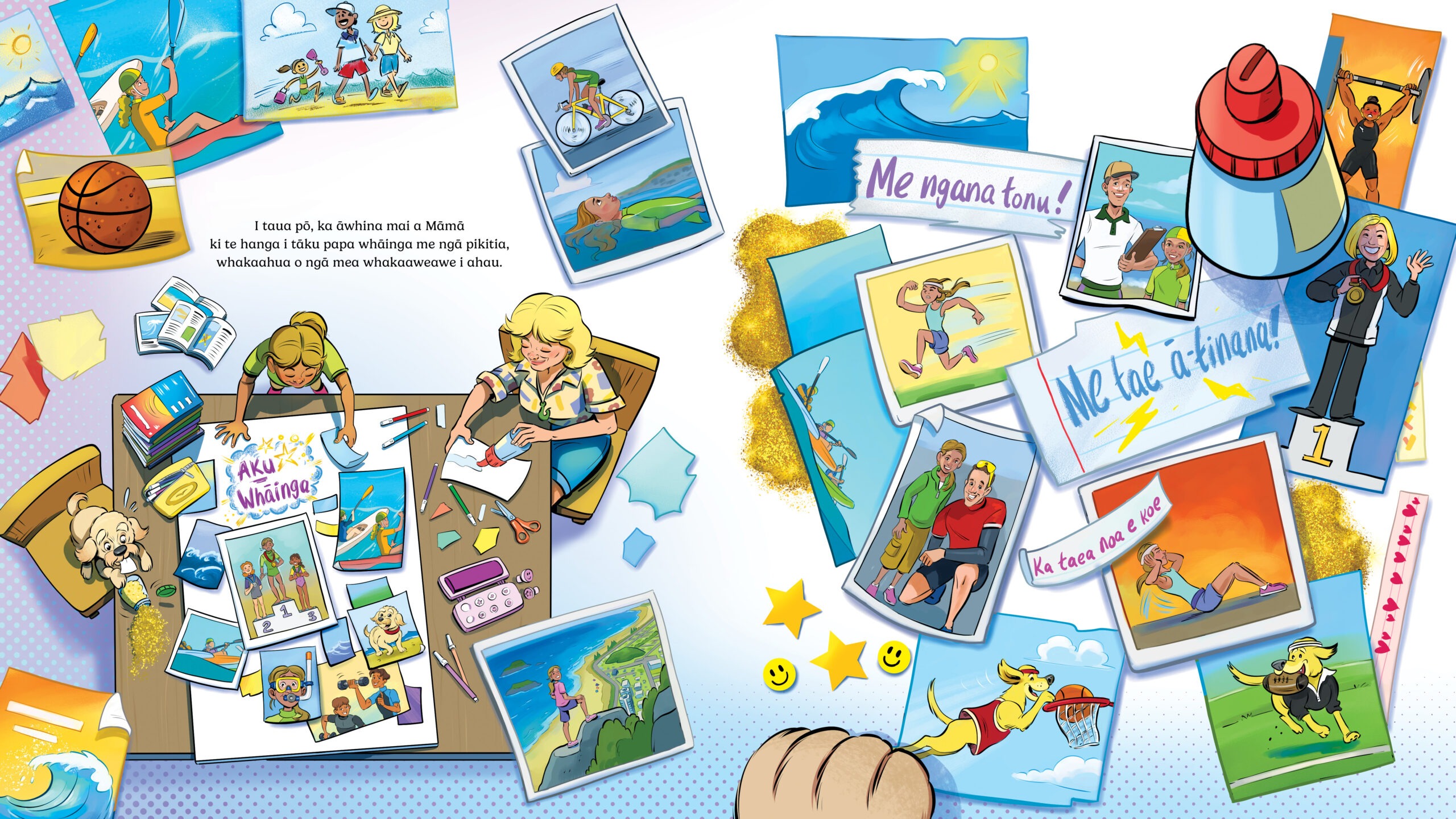
MG: The extent of your training from a young age might come as quite a surprise to some children. What do you hope this will inspire in children?
LC: Sport is fun and when you are young, it is about balance. As a kid, I got stuck into everything. I played netball and tennis; I did swimming and surf lifesaving. I didn’t start training to be competitive until I was in my mid-teens. This book serves to illustrate determination and perseverance. It shows that to grow through challenges, sometimes you need to work hard.
MG: Your story shows competitors can be supportive of each other even though competing against each other. How important was it to include this message in the story?
LC: It’s really important to understand that in the context of sport, the people we race or compete against are there to make us better. But really the only people we are trying to chase or beat is ourselves.
MG: I really like how you include your whānau in the book. Tell us about the ways your family helped you achieve your successful sporting career?
LC: I’m very close with my family. So many of my favourite childhood memories are of my brothers and I at the beach. We would happily play outside and be out in the surf for hours. I think this foundation of fun is what spurred me to stay in sport right through to my teens, and then pursue it in an elite way later in life.
This book serves to illustrate determination and perseverance.
MG: When did you realise your key message would be ‘Your best is good enough’ and why that one?
LC: This is an iteration of what my parents would say to me. I hope readers—and parents of readers—are empowered by this message too.
MG: Before the big competition in the story, you closed your eyes and centred yourself. Is this something you still do before a competition?
LC: Absolutely. In high pressure moments and environments, I call on techniques such as this to help focus and ground me.
MG: The phrase, ‘It’s not all rainbows and butterflies, but I keep showing up’, will amuse and inform children. It’s another important message. Is it a phrase you often use, or did it come from a parent or coach?
LC: It’s a way to explain that sometimes things are hard, but that you also need to persevere.
MG: There’s a scattering of Te Reo Māori in the story. Did you include those or were they suggested by the editor? Who translated the story for the Māori version?
LC: I’m on my reo journey, so incorporating it in the story was really important to me. Huia Publishers helped me to do this in a very seamless way. Huia Publishing translated the Māori version of the story in-house.
MG: Scott Pearson’s illustrations really capture the joy you felt when paddle-boarding and being outdoors. How did you feel when you saw the pictures for the first time? Did you ask for anything to be changed or did they capture what you felt from the get-go?
LC: I love the illustrations. He has captured young Lisa and the essence of all the characters perfectly. I especially love how he’s portrayed my mum and dad. There was nothing I needed him to change.
I’m on my reo journey…
MG: Did you feel nervous writing your first story for children and how did you get around your fear of writing it?
LC: Yes, as it’s not something I’ve done before. But I’m also very excited to get it out there as it’s provided a way for me to share things I’ve learnt from my journey through sport. It’s been a really fulfilling creative outlet.
MG: You’ve included your cute Cavoodle (a cross between a poodle and a Cavalier King Charles spaniel) dog Colin in the story. Is this the dog you have in your life now, or have you had a series of dogs since you were eight years old? And what do you think Colin adds to the story?
LC: Colin is my dog now and a big part of my life. He adds an element of fun, mischief and companionship. He’s one of my biggest fans in the story, helping me through when times get tough, and celebrating the wins, big and small. We all need a Colin in our lives.
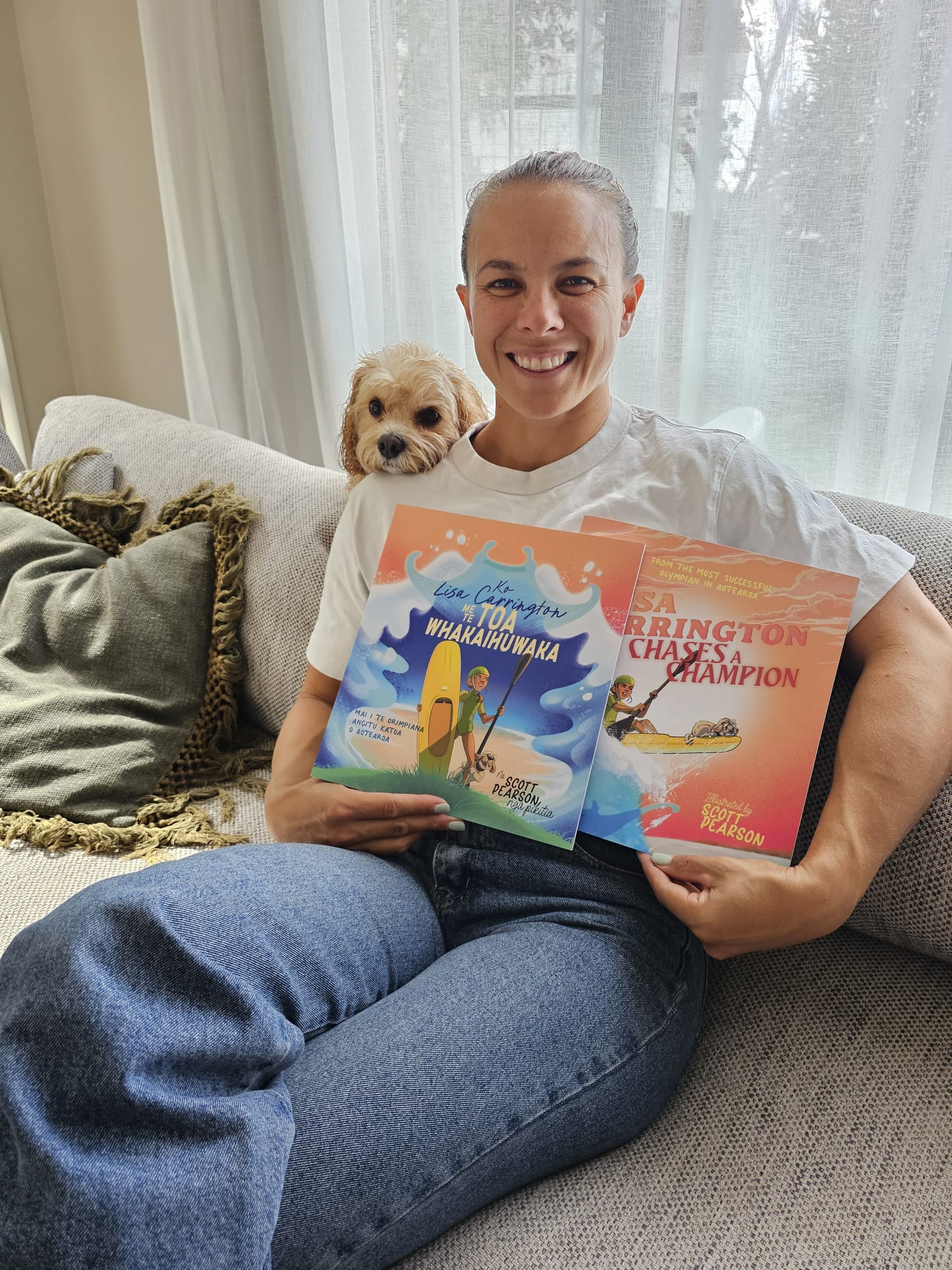
MG: Will you compete in another Olympic Games or are you retiring? If so, what are your plans? For example, are you planning to write more books?
LC: The book concludes with me thinking about my next adventure, so I guess all I can say is, watch this space!
The artwork really complements the book, and so I contacted Scott Pearson and asked him some questions, too. Scott has had over twenty years’ experience as a freelance illustrator and has a Bachelor of Media Arts. His company Visual Evolution, whichhe runs with his wife Leonie Pearson, specialises in storyboarding, newspaper cartooning, marketing visuals, animations, and of course illustration. He has illustrated over twenty books, including Te Rau, Shhh! Don’t Wake the Baby, and The Hunt for the Whistle: A Cleft Adventure.
MG: What or who inspired you to draw?
Scott Pearson (SP): There are far too many influences to mention, but I absolutely loved reading comic books such as Asterix and Tintin as a child. I had an awesome primary school library filled with these books and would spend ages studying every page in great detail. The a-ha moment was when I was around 9 years old and my classmates kept asking me to draw stuff for them, that I realised I might be onto something.
MG: What is your drawing routine like? Has it always been like that?
SP: Daily! I treat it just like a regular job. I start at the beginning of the day and finish at the end, only usually it’s hard to stop. I’m a workaholic but it’s not a job when you love what you do! It wasn’t always that way though. I started freelancing occasionally while I was still studying for my Bachelor of Media Arts degree and that continued part-time for a few years before I gave it a go full-time.
MG: What was your first reaction when the Huia editor asked you to illustrate a book about Dame Lisa Carrington?
SP: I instantly could see the great potential. The story is set in the 1990s at Lisa’s local surf club, featuring a variety of interesting characters to illustrate.
MG: Could you please show us the development of some of the characters in the story?
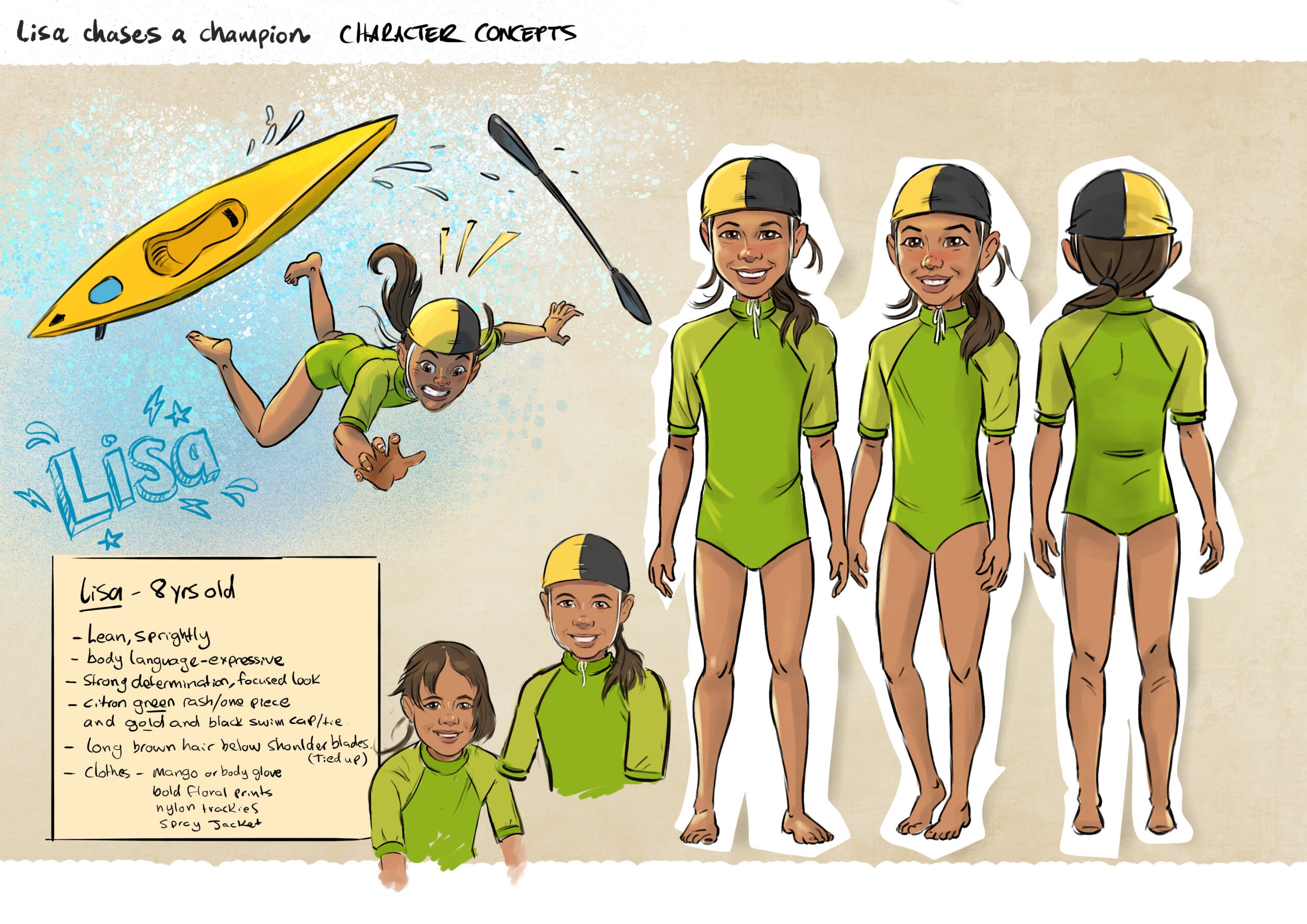
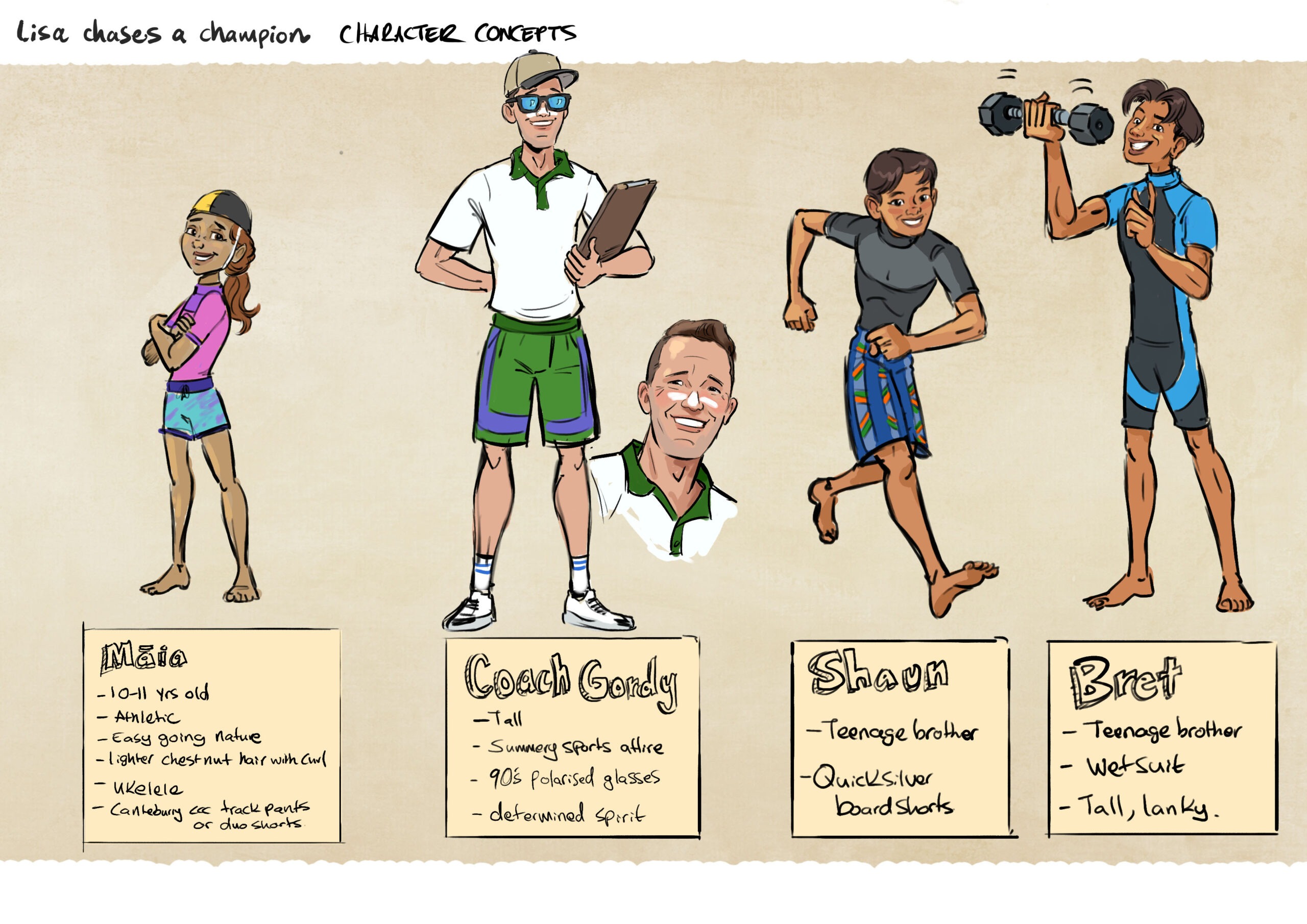
MG: Could you please show us the process of illustrating one page?
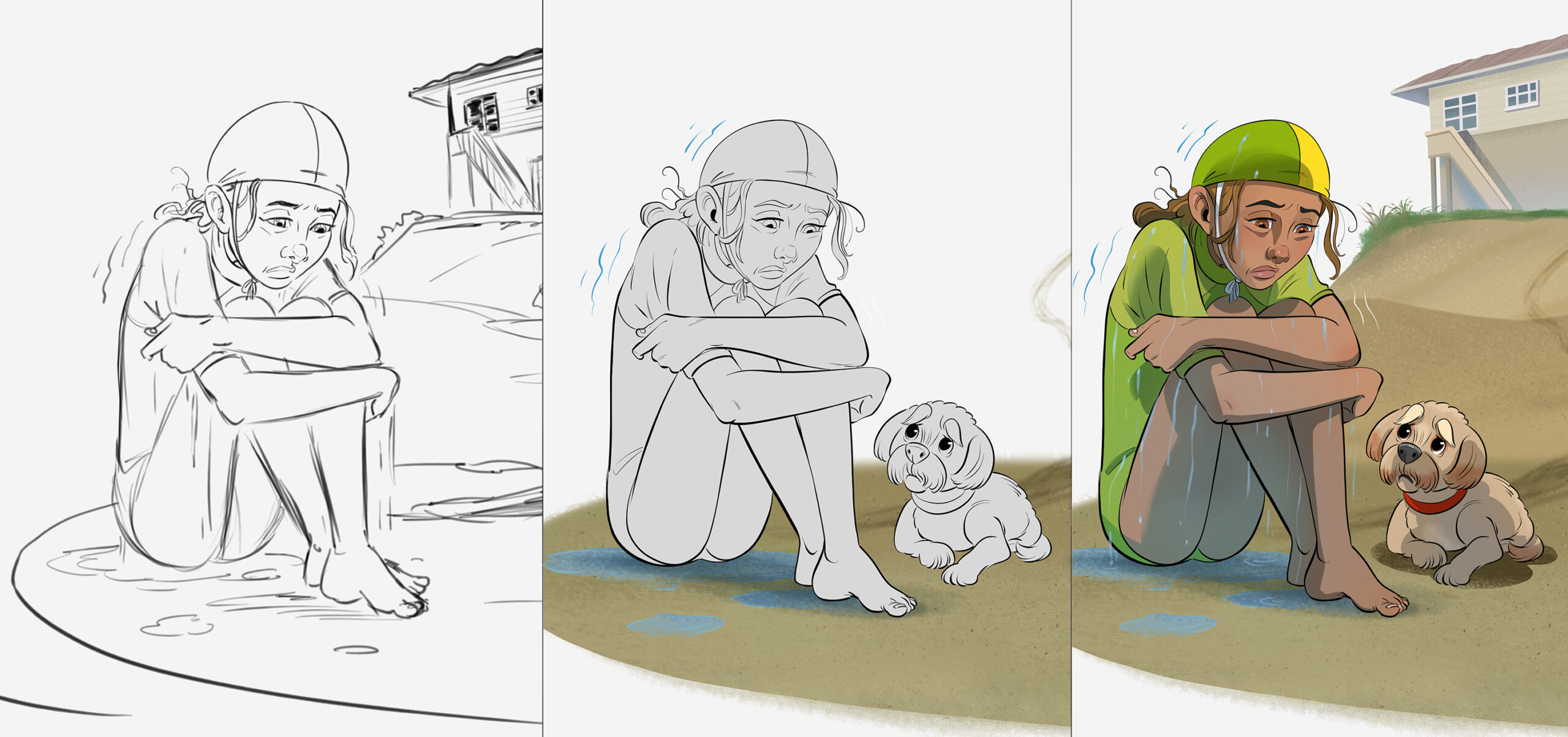
MG: What was your research process? For example, were you given photographs for reference, or did you use media photographs as reference?
SP: Both. A few family photos were supplied, which of course were extremely helpful for inspiration. There was also quite a lot of research from myself, checking the location, the types of surf ski, 90’s fashion, etc.
MG: You’ve really captured the joy that Lisa Carrington experiences when kayaking. What did you do to find that expression?
SP: I was given a couple of photos of her smiling as a child, so that was a good starting point. It was really important for the story to try and convey the changing emotions of the characters throughout.
MG: What art materials did you use to illustrate the spreads?
SP: It was all done 100% digitally using a couple of different art programmes and Photoshop for adjustments. I like to use a variety of brushes that convey texture. Because the story is set in the 90’s I used a coarse airbrush spray, bright and colourful palettes with pink and cyan hues.
Dame Lisa Carrington and Scott Pearson’s new books, Lisa Carrington Chases a Champion and Ko Lisa Carrington me te Toa Whaikaihuwaka, are available now. Dame Lisa will be doing a book-signing and meet and greet at Sylvia Park on Saturday, September 28th from 11:30 onwards outside Whitcoulls (by Farmers).
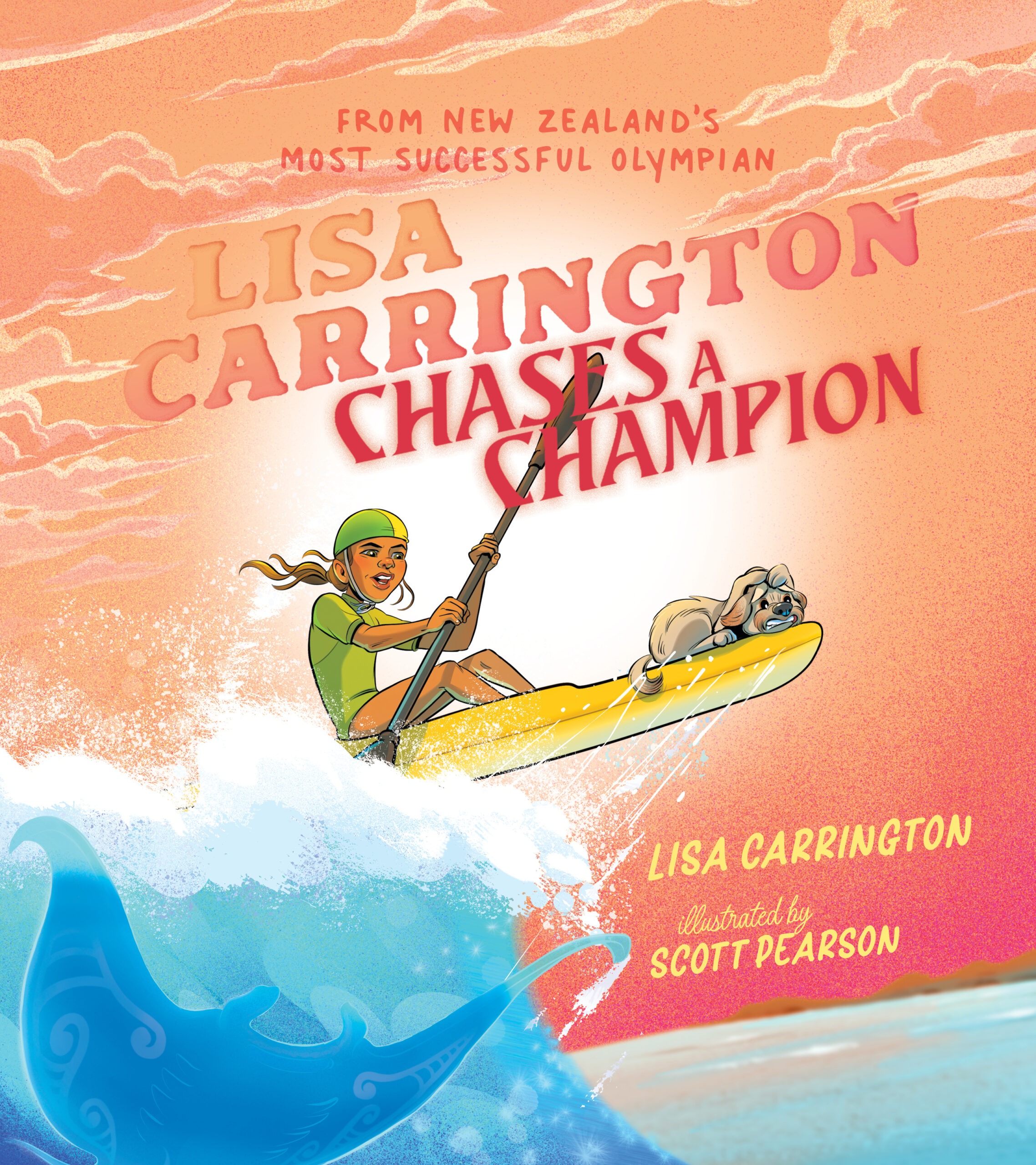
Lisa Carrington Chases a Champion
By Dame Lisa Carrington
Illustrated by Scott Pearson
Published by Huia Publishing
RRP: $27.00
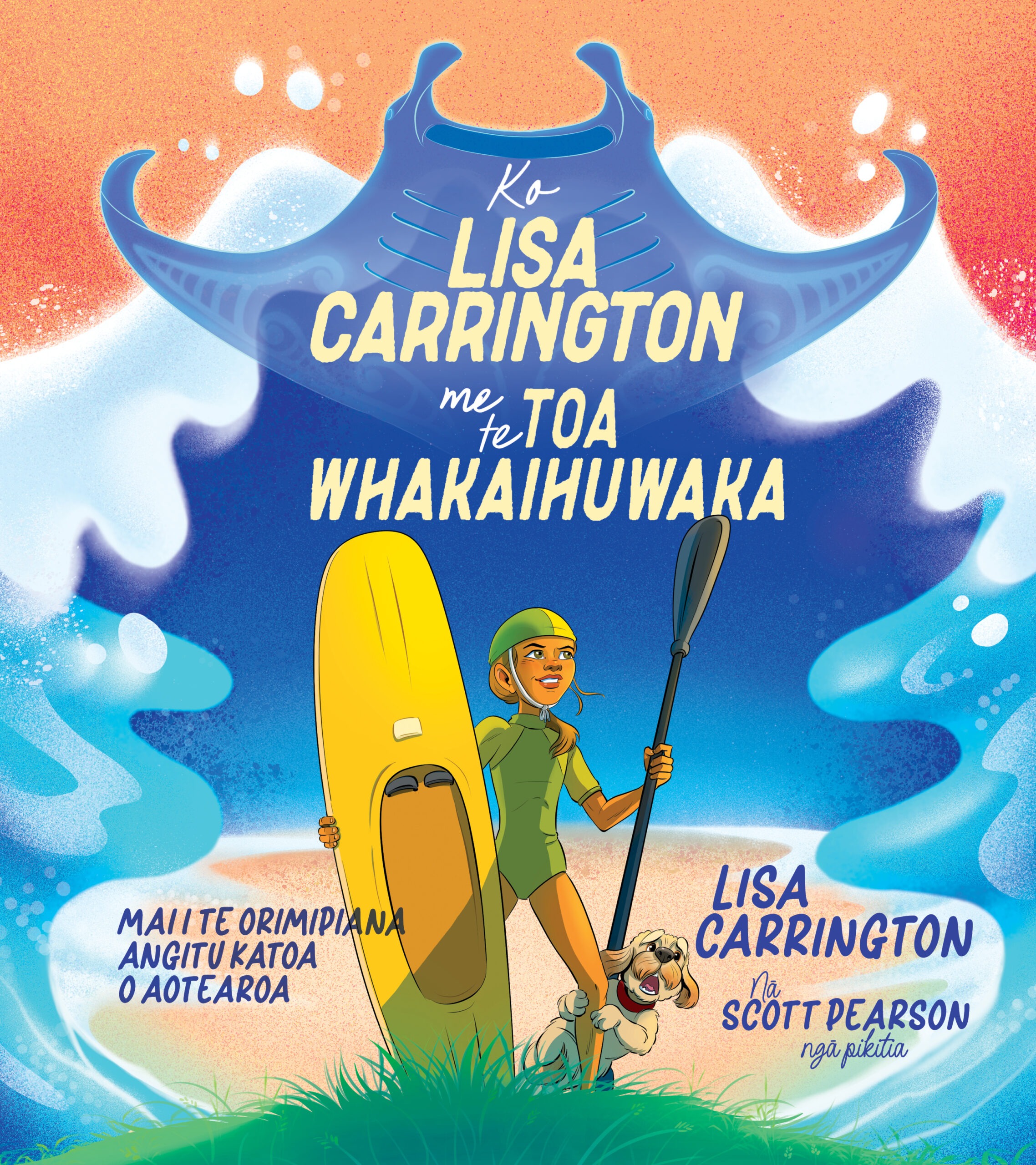
Ko Lisa Carrington me te Toa Whaikaihuwaka
Nā Lisa Carrington
Nā Scott Pearson ngā pikitia
Nā Huia i whakaputa
RRP $27.00
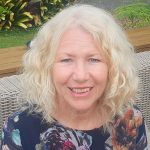
Maria Gill
Maria Gill has been writing children’s books for the last 22 years and over that time has had 62 books published. Her book Anzac Heroes won the 2016 NZCYA Book of the Year and the nonfiction prize. Storylines have awarded her books 13 Notable Book certificates in the nonfiction category and in 2020 presented Maria with the Margaret Mahy Medal for outstanding services to children’s literature. Maria has journalism and teaching degrees, and master’s in creative writing (Honours). Her latest books include Queen of the Cosmos: Beatrice Hill Tinsley and New Zealand’s Endangered Dolphins. www.mariagill.co.nz



